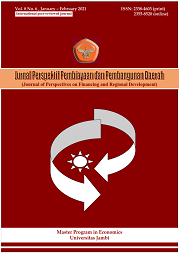Coronavirus Diseases -19: an overview in education, agriculture, and communication perspectives
DOI:
https://doi.org/10.22437/ppd.v9i1.10819Keywords:
Agriculture, Communication, COVID -19, EducationAbstract
As it emerged at the end of December 2020 in Wuhan, China, Coronavirus has now spread to many countries, which affected several sectors of human life. This paper aims to describe the impact of covid-19 on education, agriculture, and communication in Indonesia. In education, COVID-19 impacted the teaching methods. Teachers utilized e-learning during the COVID-19 pandemic, such as Schoology, Edmodo, Google Classroom, Facebook, WhatsApp, and Zoom. In agriculture, coronavirus impacted downstream and upstream agriculture. As the main food producer, farmers should be protected from the dangers of the coronavirus to maintain food security. All people need to consume food based on agricultural products. In communication, coronavirus makes society change in the use of communication media. New media is more interactive and creates a new understanding of interpersonal communication.
Downloads
References
Ali, M,S,S. (2020). Pertanian di Era Pandemi Covid-19. Presented at Webinar Department of Socio-Economics of Agriculture. Universitas Hasanuddin. June 5, 2020
Anwaruddin, M.J.S., L.S. Apri, M.K. Aditia & H. Yusdar. (2015). The Dynamics of production and Chili Price Volatility: Strategy Anticipate and Development Policy. Pengembangan Inovasi Pertanian, 8(1), 33-42.
Badan Meteorologi dan Geofisika, (2020). Prakiraan Musim Kemarau Tahun 2020 Di Indonesia. Jakarta: BMKG
Banditvilai, Ci. (2016). “Enhancing Students’ Language Skills through Blended Learning.†Electronic Journal of E-Learning, 14(3), 220–29.
Bell, D. (2006). An Introduction to Cybercultures. Routledge
Bielousova, R. (2017). Developing Materials for English for Specific Purposes Online Course within the Blended Learning Concept. TEM Journal, 6(3), 637–42.
Biocca, F. & Levy, M.R. eds., (2013). Communication in the age of virtual reality. Routledge.
Bowen,G. (2009). Document Analysis as a Qualitative Research Method. Qualitative Research Journal, 9(2), 27-40.
Central Bureau of Statistics. (2017). Indonesia dalam Angka. Jakarta: BPS
Daragmeh, A.M. (2011). Teaching ESP in a Blended Learning Setting. Journal of Educational and Instructional Studies In The World, 1(1), 1–9.
Dogoriti, E., Jenny, P., & Gregory S. A. (2014). The Use of Social Networking and Learning Management Systems in English Language Teaching in Higher Education. Campus-Wide Information Systems, 31(4), 254–63.
Ellis, K. & Goggin, G. (2015). Disability and the Media. Macmillan International Higher Education.
Food Agriculture Organization, (1983). World Food Security: a Reappraisal of the Concepts and Approaches. Rome: FAO.
Food Agriculture Organization. (2002). The State of Food Insecurity in the World2001. Rome: FAO
Food Agriculture Organization. (2020). Early Warning, Early Action: report on Food Security and Agriculture. Rome: FAO
Farias, D P. & Araujo, F.F. (2020). Will Covid-19 Affect Food Supply Chain in Distribution Centers of Brazilian Regions Affected by the Pandemic? Trends in Food Science & Technology, 103, 361-366
Hancock, B. & Windridge, K. (2009). An Introduction of Qualitative Research. Birmingham: University of Birmingham.
Hecht, A.A., Erin, B., Daniel J. B. & Roni A.N. (2019). Urban Food Supply Chain Resilience for Crises Threatening Food Security: A Qualitative Study. Journal of the Academy of Nutrition and Dietetics, 119(2), 211–24.
Hanani, N. (2020). Ekonomi Pangan Berbasis Masyarakat dalam Mengarungi Pandemi COvid-19. Presented at Focus Group Discussion, Agricultural Economics, Universitas Brawijaya, May 6, 2020
Indrawan, D. (2020). Covid-19: Economic Impact and Exist Strategy for Indonesia’s Economy. Presented at: School of Business, IPB University on Webinar April 25, 2020 by PCI NU, Netherland.
Littlejohn, S. W. & K. A. Foss. (2009). Encyclopedia Of Communication Theory . Sage Publication, Inc.
Lungu, I. (2013). The Increasing Need for Blended-Learning Models in Courses of English for Specific Courses in Romanian Universities. Procedia - Social and Behavioral Sciences, 76, 470–75.
Mcewen, C.A., & Mcewen, B.S. (2017). Social Structure, Adversity, Toxic Stress, and Intergenerational Poverty: An Early Childhood Model. Annual Review of Sociology, 43, 445–72.
Ministry of Agriculture of Indonesia. (2020). New Normal: Tantangan dan Perubahan Masyarakat Tani Masa Covid-19. Presented at Webinar Faperta Universitas Hasanuddin, Indonesia, June 5, 2020.
Morgan, S. & Allen, H. (2020). Assessment for Online Learning. Cambridge Assessment English Webinar, May 22, 2020.
Nur’Aini, I. (2017). Need Analysis in English for Specific Purposes at Vocational School. 2nd NEDS Proceedings 125–36.
Padjung, R. (2018). Improving Agricultural Commodity Supply-Chain to Promote Economic Activities in Rural Area. IOP Conference Series: Earth and Environmental Science 157(1).
Patanjengi, B. (2020). Potret Petani Pasca Pandemi Covid-19 Menyongsong Era New Normal. Agriculture Faculty, Universitas Hasanuddin
Perry, S.D. (2004). Media: A Tool To Meet Our Needs. in Baldwin, J. R., Perry, Sd, & Moffit, M.A. Communication Theories For Everyday Life. Boston: Pearson Education, Inc.
Poster, M., (2002). Digital networks and citizenship. Publications of the Modern Language Association of America, 117(1),.98-103.
Saha, A.A. (1994). Two-Season Agricultural Household Model of Output and Price Uncertainty. Journal of Development Economics, 45, 245-269.
Sukarni, E.I., Winarni, D. & Nirmayanti, Y.T. (2015). “Improving Teachers’ Professionalism Through Materials Development, Information Technology and Classroom Action Research.†TEFLIN Journal 20(2):212–31.
Sulisworo, D. (2018). “Blended Learning: Improving Student’s Motivation in English Teaching Learning Process.†International Journal of Languages’ Education 1(Volume 6 Issue 1):163–70.
Toledo, P. & Costa, J.A. (2020). Assessing Writing Online. Cambridge Assessment English Webinar on June 5, 2020.
Vu, X.H. (2015). Active Learning in an ICT-Enhanced Blended Learning Environment : A Case Study of Vietnamese Students in Australian Higher Education. [Doctoral Dissertation], School of Education, University of Wollongong,
Yi-Chi, W., Ching-Sung, C., & Yu-Jiun, C. (2020). The Outbreak of COVID-19:An Overview. Journal of The Chinese Medical Assosiation, 83(3), 217-220.
Wulandari, E., Supyandi, D. & Ernah. (2020). The Risk Measurement of Horticultural Price: A Comparison Based on Financial Access in West Java, Indonesia. Sains Malaysiana 49(3), 713–19.
Yusuf, A.A., Suganda, T., Hermanto, Mansur, F. & Hadisoemarto, P. (2020). Strategi Ekonomi Sektor Pertanian di Tengah Pandemi Covid-19. Center for Sustainable Development Goals Studies, Universitas Padjadjaran
Zainuddin, Z., & Keumala, C.M. (2018). Blended Learning Method Within Indonesian Higher Education Institutions. Jurnal Pendidikan Humaniora, 6(2), 69-77.
Downloads
Published
How to Cite
Issue
Section
License
Copyright (c) 2021 Ikawati Karim, Indah Nur Aini, M. Fikri Akbar

This work is licensed under a Creative Commons Attribution 4.0 International License.

















